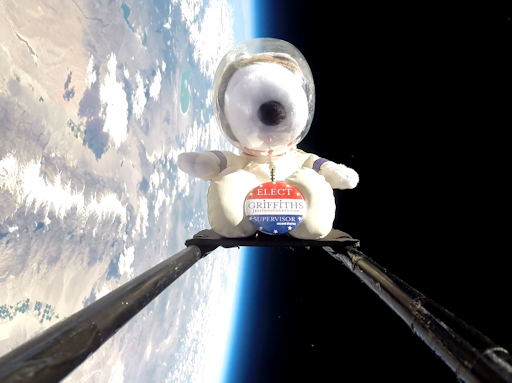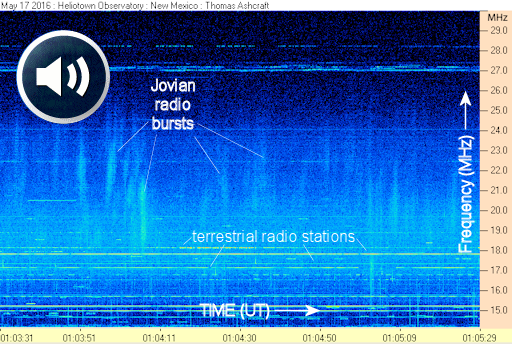It's waiting for you: The most successful Aurora Photo Tour on Earth! 100% success rate 4 years in a row and winner of the TripAdvisor Certificate of Excellence Award. Join LapplandMedia's aurora tours in Abisko, Swedish Lapland! | | | THE SUN IS FLATLINING: With no sunspots actively flaring, the sun's X-ray output is flatlining. This situation is likely to continue. NOAA forecasters say there is no more than a 1% chance of strong flares for the next 3 days. Solar flare alerts: text, voice. PHOTOGENIC SUNSPOT: Usually when a sunspot is really big, it is also really active. Not so for sunspot AR2546, a behemoth big enough to swallow Earth yet at the same time stubbornly quiet. Since it appeared 10 days ago, AR2546 has not unleashed a single significant solar flare. On the bright side, it's photogenic. Piotr Wieczorek sends this picture from Jantar, Poland: 
"As the sun rose above the Gulf of Danzig on May 22nd, the morning clouds acted as a natural filter, allowing me to photograph this big sunspot," says Wieczorek. Wieczorek's photo also captured a mirage. Note the melted shape of the solar disk just behind the passing birds. This is caused by a layer of warmer and less dense air close to the water's surface. Many photographers have captured similar images in recent days. Browse the photo gallery for examples. Caution: Even when the sun is dimmed by low-hanging clouds or haze, it can still be dangerously bright. If you chose to photograph the low sun, as Wieczorek did, use the camera's LCD screen for safe viewfinding. Never look into the eyepiece of an unfiltered camera or telescope when the sun is in the field of view. Realtime Space Weather Photo Gallery SNOOPY AT THE EDGE OF SPACE: On May 15th, Spaceweather.com and the students of Earth to Sky Calculus launched Snoopy to the edge of space--and set a high-altitude record for political campaigning. The high-altitude balloon flight was sponsored by Inyo County Supervisor Jeff Griffiths, who is running for re-election. Snoopy carried his campaign pin 115,700 feet: 
Griffith's generous donation to the students not only paid for his Edge of Space campaign ad, but also allowed us to continue our atmospheric radiation monitoring program. Valuable data were collected by cosmic ray sensors inside the payload, confirming our previous finding that cosmic rays are intensifying. Thanks, Jeff! Readers, if you would like to send a small item or photo to space--and sponsor student research at the same time--the cost is $500. Contact Dr. Tony Phillips to book your flight. RADIO STORM ON JUPITER: Earlier this week, there was a storm on Jupiter--a radio storm. Amateur radio astronomer Thomas Ashcraft recorded the event on May 17th using a shortwave radio telescope located in New Mexico. Click on the image to hear the whooshing sounds that emerged from his telescope's loudspeaker: 
"This was a strong storm," says Ashcraft. "The audio recording captures the sounds I heard during one minute around 01:04 UT." Jupiter's radio storms are caused by natural radio lasers in the planet's magnetosphere that sweep past Earth as Jupiter rotates. Electrical currents flowing between Jupiter's upper atmosphere and the volcanic moon Io can boost these emissions to power levels easily detected by ham radio antennas on Earth. Jovian "S-bursts" (short bursts) and "L-bursts" (long bursts) mimic the sounds of woodpeckers, whales, and waves crashing on the beach. Here are a few audio samples: S-bursts, S-bursts (slowed down 128:1), L-Bursts Now is a good time to listen to Jupiter's radio storms. The giant planet is only two months past opposition (closest approach to Earth), and it is high in the sky at sunset. NASA's Radio Jove Project explains how to build your own receiver.
Realtime Aurora Photo Gallery
Realtime Comet Photo Gallery Every night, a network of NASA all-sky cameras scans the skies above the United States for meteoritic fireballs. Automated software maintained by NASA's Meteoroid Environment Office calculates their orbits, velocity, penetration depth in Earth's atmosphere and many other characteristics. Daily results are presented here on Spaceweather.com. On May. 23, 2016, the network reported 7 fireballs.
(7 sporadics)  In this diagram of the inner solar system, all of the fireball orbits intersect at a single point--Earth. The orbits are color-coded by velocity, from slow (red) to fast (blue). [Larger image] [movies] Potentially Hazardous Asteroids ( PHAs) are space rocks larger than approximately 100m that can come closer to Earth than 0.05 AU. None of the known PHAs is on a collision course with our planet, although astronomers are finding new ones all the time. On May 23, 2016 there were 1701 potentially hazardous asteroids. Notes: LD means "Lunar Distance." 1 LD = 384,401 km, the distance between Earth and the Moon. 1 LD also equals 0.00256 AU. MAG is the visual magnitude of the asteroid on the date of closest approach. | | Cosmic Rays in the Atmosphere | | Situation Report -- Oct. 30, 2015 | Stratospheric Radiation (+37o N) | | Cosmic ray levels are elevated (+6.1% above the Space Age median). The trend is flat. Cosmic ray levels have increased +0% in the past month. | | Sept. 06: 4.14 uSv/hr (414 uRad/hr) | | Sept. 12: 4.09 uSv/hr (409 uRad/hr) | | Sept. 23: 4.12 uSv/hr (412 uRad/hr) | | Sept. 25: 4.16 uSv/hr (416 uRad/hr) | | Sept. 27: 4.13 uSv/hr (413 uRad/hr) | | Oct. 11: 4.02 uSv/hr (402 uRad/hr) | | Oct. 22: 4.11 uSv/hr (411 uRad/hr) | These measurements are based on regular space weather balloon flights: learn more. Approximately once a week, Spaceweather.com and the students of Earth to Sky Calculus fly "space weather balloons" to the stratosphere over California. These balloons are equipped with radiation sensors that detect cosmic rays, a surprisingly "down to Earth" form of space weather. Cosmic rays can seed clouds, trigger lightning, and penetrate commercial airplanes. Our measurements show that someone flying back and forth across the continental USA, just once, can absorb as much ionizing radiation as 2 to 5 dental X-rays. For example, here is the data from a flight on Oct. 22, 2015: 
Radiation levels peak at the entrance to the stratosphere in a broad region called the "Pfotzer Maximum." This peak is named after physicist George Pfotzer who discovered it using balloons and Geiger tubes in the 1930s. Radiation levels there are more than 80x sea level. Note that the bottom of the Pfotzer Maximim is near 55,000 ft. This means that some high-flying aircraft are not far from the zone of maximum radiation. Indeed, according to the Oct 22th measurements, a plane flying at 45,000 feet is exposed to 2.79 uSv/hr. At that rate, a passenger would absorb about one dental X-ray's worth of radiation in about 5 hours. The radiation sensors onboard our helium balloons detect X-rays and gamma-rays in the energy range 10 keV to 20 MeV. These energies span the range of medical X-ray machines and airport security scanners. | | The official U.S. government space weather bureau | | | The first place to look for information about sundogs, pillars, rainbows and related phenomena. | | | Researchers call it a "Hubble for the sun." SDO is the most advanced solar observatory ever. | | | 3D views of the sun from NASA's Solar and Terrestrial Relations Observatory | | | Realtime and archival images of the Sun from SOHO. | | | from the NOAA Space Environment Center | | | the underlying science of space weather |  | Claim your tax refund with this UK tax rebate company and get back your overpaid tax. |  | Enjoy this fabulous range of leather sofas from a leader in the UK sofa manufacturer industry.. | | 
